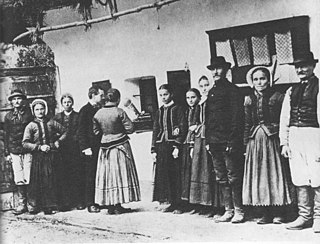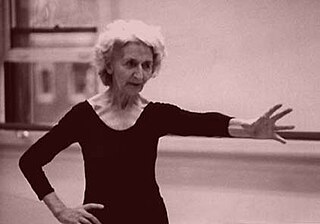
Dance is a performing art form consisting of sequences of movement, either improvised or purposefully selected. This movement has aesthetic and often symbolic value. Dance can be categorized and described by its choreography, by its repertoire of movements, or by its historical period or place of origin.

Folk music includes traditional folk music and the contemporary genre that evolved from it during the 20th-century folk revival. Some types of folk music may be called world music. Traditional folk music has been defined in several ways: as music transmitted orally, music with unknown composers, music that is played on traditional instruments, music about cultural or national identity, music that changes between generations, music associated with a people's folklore or music performed by custom over a long period of time. It has been contrasted with commercial and classical styles. The term originated in the 19th century, but folk music extends beyond that.

Folklore is the expressive body of culture shared by a particular group of people; it encompasses the traditions common to that culture, subculture or group. This includes oral traditions such as tales, proverbs and jokes. They include material culture, ranging from traditional building styles to handmade toys common to the group. Folklore also includes customary lore, taking actions for folk beliefs, the forms and rituals of celebrations such as Christmas and weddings, folk dances and initiation rites. Each one of these, either singly or in combination, is considered a folklore artifact. Just as essential as the form, folklore also encompasses the transmission of these artifacts from one region to another or from one generation to the next. Folklore is not something one can typically gain in a formal school curriculum or study in the fine arts. Instead, these traditions are passed along informally from one individual to another either through verbal instruction or demonstration. The academic study of folklore is called folklore studies or folkloristics, and it can be explored at undergraduate, graduate and Ph.D. levels.

Ethnomusicology is the study of music from the cultural and social aspects of the people who make it. It encompasses distinct theoretical and methodical approaches that emphasize cultural, social, material, cognitive, biological, and other dimensions or contexts of musical behavior, in addition to the sound component.
A roots revival is a trend which includes young performers popularizing the traditional musical styles of their ancestors. Often, roots revivals include an addition of newly composed songs with socially and politically aware lyrics, as well as a general modernization of the folk sound.

Alan Lomax was an American ethnomusicologist, best known for his numerous field recordings of folk music of the 20th century. He was also a musician himself, as well as a folklorist, archivist, writer, scholar, political activist, oral historian, and film-maker. Lomax produced recordings, concerts, and radio shows in the US and in England, which played an important role in preserving folk music traditions in both countries, and helped start both the American and British folk revivals of the 1940s, 1950s and early 1960s. He collected material first with his father, folklorist and collector John Lomax, and later alone and with others, Lomax recorded thousands of songs and interviews for the Archive of American Folk Song, of which he was the director, at the Library of Congress on aluminum and acetate discs.
Themusic of Italy has traditionally been one of the cultural markers of Italian national and ethnic identity and holds an important position in society and in politics. Italian music innovation – in musical scale, harmony, notation, and theatre – enabled the development of opera, in the late 16th century, and much of modern European classical music – such as the symphony and concerto – ranges across a broad spectrum of opera and instrumental classical music and popular music drawn from both native and imported sources.
Laban movement analysis (LMA), sometimes Laban/Bartenieff movement analysis, is a method and language for describing, visualizing, interpreting and documenting human movement. It is based on the original work of Rudolf Laban, which was developed and extended by Lisa Ullmann, Irmgard Bartenieff, Warren Lamb and others. LMA draws from multiple fields including anatomy, kinesiology and psychology. It is used by dancers, actors, musicians and athletes; by health professionals such as physical and occupational therapists and psychotherapists; and in anthropology, business consulting and leadership development.
Industrial folk music, industrial folk song, industrial work song or working song is a subgenre of folk or traditional music that developed from the 18th century, particularly in Britain and North America, with songs dealing with the lives and experiences of industrial workers. The origins of industrial folk song are in the British industrial revolution of the eighteenth century as workers tended to take the forms of music with which they were familiar, including ballads and agricultural work songs, and adapt them to their new experiences and circumstances. They also developed in France and the US as these countries began to industrialise.

Music of Punjab reflects the traditions of the Punjab region of the Indian subcontinent, currently divided into two parts: East Punjab and West Punjab. The Punjab has diverse styles of music, ranging from folk and Sufi to classical, notably the Patiala gharana. While this style of music is, obviously, most popular in Punjab, it has seen popularity in many diverse and different areas of the world, such as Southern Ontario.
Homologies are "structural 'resonances'...between the different elements making up a socio-cultural whole."
Ganga is a type of singing that originated from rural Dinaric mountain region. It is most commonly found in the regions of Herzegovina and Dalmatia, but it can also be found to an extent in western Bosnia, Lika, Kordun and rural areas of north-west Montenegro. It is characterized by a lone singer singing a single line of lyrics, followed by others joining in, using a vocal style that is best described as a wail.
Italian folk music has a deep and complex history. National unification came quite late to the Italian peninsula, so its many hundreds of separate cultures remained un-homogenized until quite recently compared to many other European countries. Moreover, Italian folk music reflects Italy's geographic position at the south of Europe and in the center of the Mediterranean Sea: Arabic, African, Celtic, Persian, and Slavic influences are readily apparent in the musical styles of the Italian regions. Italy's rough geography and the historic dominance of small city states has allowed quite diverse musical styles to coexist in close proximity.

Ethnochoreology is the study of dance through the application of a number of disciplines such as anthropology, musicology, ethnomusicology, and ethnography. The word itself is relatively recent and etymologically means “the study of ethnic dance”, though this is not exclusive of research on more formalized dance forms, such as classical ballet, for example. Thus, ethnochoreology reflects the relatively recent attempt to apply academic thought to why people dance and what it means.
Anna Lomax Wood is an anthropologist, ethnomusicologist and public folklorist. She is the President of the Association for Cultural Equity (ACE), established in 1985 by her father, musicologist Alan Lomax, at Hunter College, CUNY.
The Laban/Bartenieff Institute of Movement Studies (LIMS) in New York was founded in 1978 as a center for the development and study of the principles of Laban Movement Analysis, formulated by Rudolf Laban and further developed by his student and colleague Irmgard Bartenieff. The institute maintains a library and media resource center that includes published and unpublished text, films and photographs on the subject of Laban Movement Analysis.

Irmgard Bartenieff was a dance theorist, dancer, choreographer, physical therapist, and a leading pioneer of dance therapy. A student of Rudolf Laban, she pursued cross-cultural dance analysis, and generated a new vision of possibilities for human movement and movement training. From her experiences applying Laban’s concepts of dynamism, three-dimensional movement and mobilization to the rehabilitation of people affected by polio in the 1940s, she went on to develop her own set of movement methods and exercises, known as Bartenieff Fundamentals.
John Melville Bishop is a contemporary, U.S., documentary filmmaker known for the breadth of his collaborations, primarily in the fields of anthropology and folklore. He has worked with Alan Lomax, John Marshall, and extensively with the Smithsonian Institution and the American Folklife Center at the Library of Congress. In 2005, he received a Lifetime Achievement Award from the Society for Visual Anthropology.
Ethnomusicology is the study of music from the cultural and social aspects of the people who make it. It encompasses distinct theoretical and methodical approaches that emphasize cultural, social, material, cognitive, biological, and other dimensions or contexts of musical behavior, in addition to the sound component. While the traditional subject of musicology has been the history and literature of Western art music, ethnomusicology was developed as the study of all music as a human social and cultural phenomenon. Oskar Kolberg is regarded as one of the earliest European ethnomusicologists as he first began collecting Polish folk songs in 1839. Comparative musicology, the primary precursor to ethnomusicology, emerged in the late 19th century and early 20th century. The International Musical Society in Berlin in 1899 acted as one of the first centers for ethnomusicology. Comparative musicology and early ethnomusicology tended to focus on non-Western music, but in more recent years, the field has expanded to embrace the study of Western music from an ethnographic standpoint.
Judith Rita Cohen is a Canadian ethnomusicologist, music educator, and performer. Her research interests include Judeo-Spanish (Ladino) songs; medieval and traditional music from the Balkans, Portugal, French Canada, and Yiddish; pan-European balladry; and songs from Crypto-Jewish regions in Portugal. She has received numerous research and travel grants to do fieldwork in Spain, Portugal, Morocco, Israel, Turkey, Greece, France, Belgium, Canada, and the United States, and has published many journal articles, papers, and book chapters. She plays a variety of medieval musical instruments, and sings and performs as part of her lectures and in concerts and solo recitals. She is also the editor of the Alan Lomax Spanish collection maintained by the Association for Cultural Equity.








